
Membrane ‘Holes’ Layer
As described previously the membrane switch controller can be created by separating two sets of conductive traces with flexible insulating material in between: Creating this ‘holes’ layer was a seemingly straightforward yet laborious process – cutting 900 holes precisely ain’t…

All Things Fabric: Testing, Printing, Pricing
Fabric Testing As outlined in ‘Face’ of the Quilt, I am testing fabric to see how it diffuses, affects affect, and obscures or reveals hardware. I quickly tested a broad array of swatches. Their textures included felt, mid-weight cotton, a polyester-stretch…

The ‘Face’ of the Quilt: Fabric and Light Diffusion
Per the admittedly true cliché, you never get a second chance to make a first impression. We are reimagining the original look and feel of the 1800s quilt in modern fabrics and designs. In taking this route, we need to ensure…

Taking Membrane Switches to Scale: First Steps
Recently my lab mate and I were fantasizing about theoryland. It’s this magical place where you go up to a whiteboard and, using your extensive domain knowledge, allow ephemeral non-toxic marker to create your dream system. But no Expo could…

Prototyping Membrane Switches
Membrane switches are very simple. Physically, there are no “fancy” materials involved. It’s easy to see why they have been on our microwaves allowing us to accidentally burn PopSecret for many years and counting. With only the following materials I was…
Why Keyboards Matter
Making a matrix with 9 inputs isn’t all that bad. I wouldn’t mind wiring each one up. But when we get two orders of magnitude bigger to 900, we want something more cleverly constructed, reducing duplicity and manual labor. While…
Prototyping Capacitive Sensors
Previous blog posts explored capacitive sensing and proposed it as ideal for our digital Peabody quilt. However, unlike a smartphone or tablet, we have a very interesting design problem: how can we embody the quilt form and feel such that…
You must be logged in to post a comment.